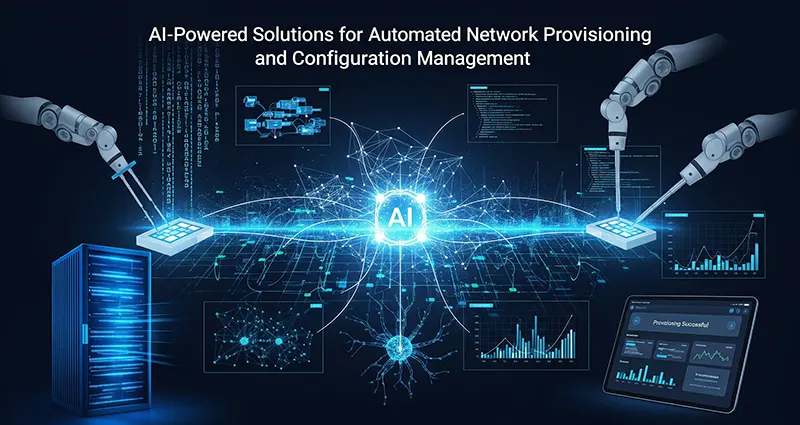In today’s fast-paced digital world, enterprise networks are becoming increasingly complex, demanding faster deployment, efficient management, and reliable performance. Traditional manual processes for network provisioning and configuration management are often time-consuming, error-prone, and resource-intensive. To address these challenges, organizations are turning to AI-powered solutions for automated network provisioning and configuration management to streamline operations and enhance network agility.
Understanding Network Provisioning and Configuration Management
Network provisioning involves setting up network resources such as switches, routers, firewalls, and other devices to prepare the infrastructure for service deployment. Configuration management ensures that these devices are properly configured, maintained, and updated throughout their lifecycle to meet organizational policies and security requirements.
Manual approaches to these tasks typically involve repetitive, rule-based workflows that are prone to human errors, leading to configuration inconsistencies, downtime, and security vulnerabilities.
How AI-Powered Solutions Revolutionize the Process
Artificial intelligence introduces automation, intelligence, and adaptability into network provisioning and configuration management by leveraging machine learning, natural language processing, and analytics. Here’s how AI transforms these critical network functions:
1. Automated Provisioning Through Intelligent Orchestration
AI algorithms analyze network requirements and automatically provision the necessary resources without human intervention. This includes dynamically allocating bandwidth, deploying virtual network functions, and integrating new devices into existing environments seamlessly.
2. Predictive Configuration Management
Machine learning models continuously monitor network performance and predict potential misconfigurations or failures before they cause issues. This proactive approach enables IT teams to address vulnerabilities and optimize configurations for improved network stability and security.
3. Policy-Driven Automation
AI facilitates the enforcement of organizational policies by automatically validating configurations against compliance standards. Intelligent engines can detect deviations and remediate configurations to ensure adherence to regulatory and security policies.
4. Natural Language Interfaces
AI-powered natural language processing allows network engineers to interact with management systems through conversational commands. This reduces the learning curve and accelerates configuration changes by translating human requests into precise network instructions.
5. Continuous Learning and Adaptation
AI systems learn from network data patterns, historical configurations, and incident responses to refine their automation strategies over time. This adaptive intelligence leads to improved decision-making and more efficient network management.
Benefits of AI-Powered Network Provisioning and Configuration Management
- Enhanced Efficiency: Automation reduces manual workload, enabling faster provisioning and configuration changes.
- Reduced Errors: AI minimizes human error risks, improving configuration accuracy and reducing downtime.
- Improved Scalability: Automated solutions effortlessly scale to manage complex, large-scale network environments.
- Greater Agility: Enterprises can quickly adapt to changing business needs and deploy new services faster.
- Strengthened Security: Continuous monitoring and automatic policy enforcement help maintain robust security postures.
Challenges and Considerations
While AI-powered solutions offer remarkable advantages, organizations should be mindful of:
- Data Quality: Effective AI requires comprehensive and accurate network data for model training and inference.
- Integration Complexity: Ensuring seamless compatibility with existing network infrastructure and management tools.
- Skill Requirements: IT teams need expertise in AI and network automation to manage and optimize these solutions.
- Change Management: Adapting organizational processes and culture to embrace AI-driven automation.
Future Outlook
The future of network provisioning and configuration management lies in greater AI integration combined with technologies like edge computing and 5G. This will enable ultra-responsive and intelligent networks capable of self-optimizing and self-healing in real time.
AI-powered solutions for automated network provisioning and configuration management are transforming how enterprises manage their networks. By enabling automation, intelligence, and adaptability, these solutions increase operational efficiency, reduce errors, and enhance security. As networks continue to grow in complexity, adopting AI-driven automation will be crucial for organizations aiming to maintain competitive, agile, and resilient IT infrastructures.











